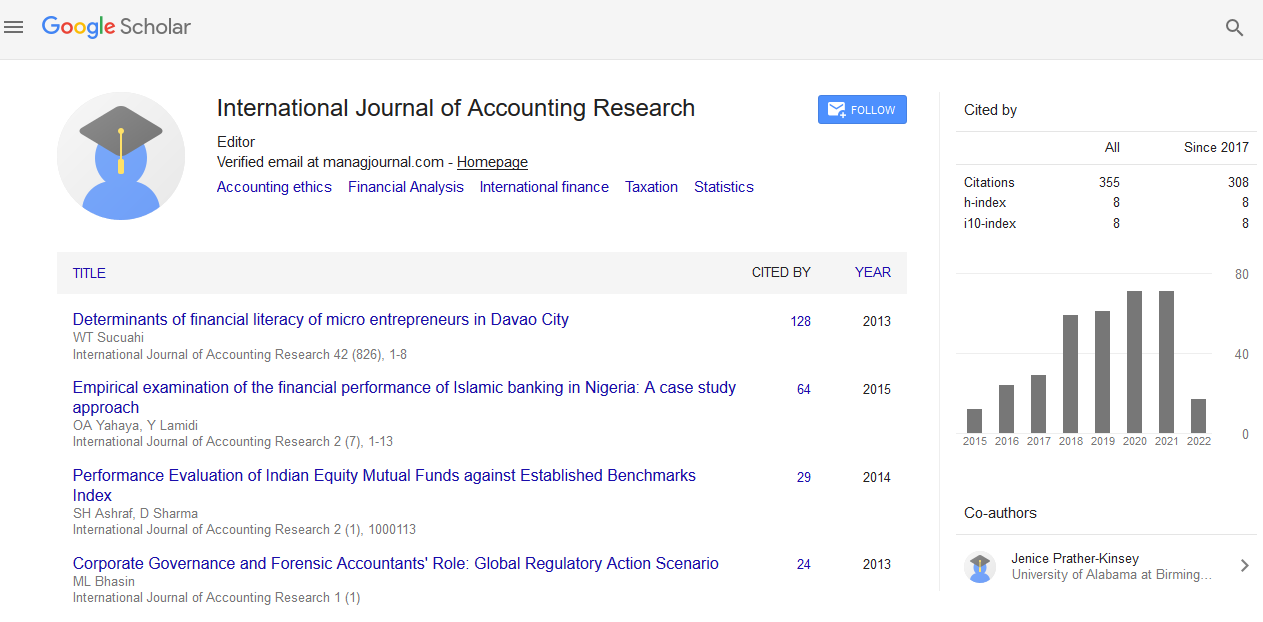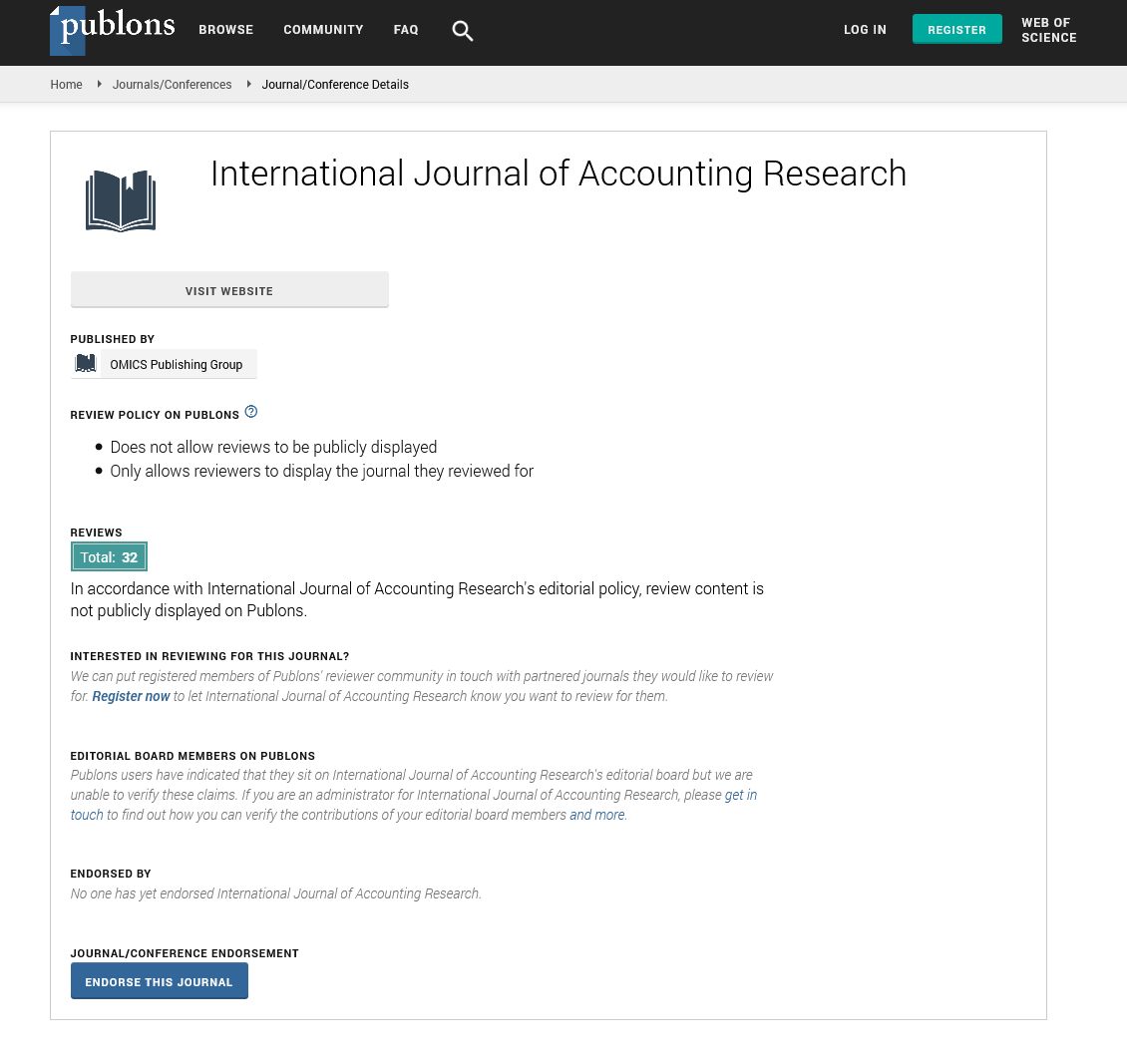Indexed In
- Open J Gate
- RefSeek
- Hamdard University
- EBSCO A-Z
- Scholarsteer
- Publons
- Euro Pub
- Google Scholar
Useful Links
Share This Page
Journal Flyer

Open Access Journals
- Agri and Aquaculture
- Biochemistry
- Bioinformatics & Systems Biology
- Business & Management
- Chemistry
- Clinical Sciences
- Engineering
- Food & Nutrition
- General Science
- Genetics & Molecular Biology
- Immunology & Microbiology
- Medical Sciences
- Neuroscience & Psychology
- Nursing & Health Care
- Pharmaceutical Sciences
Opinion Article - (2023) Volume 11, Issue 6
The Role of Shaping Current Account Positions in Macroeconomic Stability
Abdul Noor*Received: 28-Nov-2023, Manuscript No. IJAR-23-24155; Editor assigned: 30-Nov-2023, Pre QC No. IJAR-23-24155 (PQ); Reviewed: 15-Dec-2023, QC No. IJAR-23-24155; Revised: 22-Dec-2023, Manuscript No. IJAR-23-24155 (R); Published: 29-Dec-2023, DOI: 10.35248/2472-114X.23.11.366
Description
The role of macroeconomic stability on current account balances has not been explored using a computed measure. For the first time in the study, it aims to discover the role of macroeconomic stability in current account balances. The macroeconomic stability is represented by an index composed of all countries' affectation rate, growth rate, severance rate, and financial balance statistics. It has been established that macroeconomic stability is a major predictor of current account balances, alongside institutional quality and fiscal development [1-5].
Macroeconomic stability is defined as the balance of important profitability factors. There is no obvious line between stability and insecurity. It is the assessment of various combinations of important profitability variables such as growth rate, affectation rate, financial balance, severance, debt position, and current account poverty that provide information on macroeconomic stability. Nonetheless, large current account deficits financed by short-term borrowing, a high severance rate, a high position of adding public debt, two integers adding affectation rates, and negative or declining Gross Domestic Product (GDP) growth rates demonstrate a country's position of macroeconomic instability rather fluently [6-8].
Similarly, macroeconomic stability is indicated by a positive financial balance, a current account balance that is with diminishing debt situations, a dwindling affectation rate in one number, and an increasing growth rate. Moreover, empirical studies demonstrate a favorable association between macroeconomic stability and Foreign Direct Investment (FDI) inflows.
Macroeconomic stabilization is a critical issue for policymakers in all countries, regardless of their stage of development. Although the indicators used to evaluate macroeconomic stability are defined differently, it boosts countries' ability to help and absorb various external and internal shocks, as well as husbandry's capacity to limit negative goods. Macroeconomic stabilization is thus assessed in a variety of ways, based on the goal of the analysis and the conclusion of the governments' lucrative initiatives. These indicators should not be viewed alone because they are very interrelated. For example, high foreign debt does not necessarily indicate low macroeconomic stability if the debt is employed for investment reasons, which increases growth rates.
For the first time in the study, it aims to discover the role of macroeconomic stability in current account balances. The macroeconomic stability is represented by an index composed of all countries' affectation rate, growth rate, severance rate, and financial balance statistics [9].
The analysis incorporates seven macroeconomic factors. Growth rate, terms of trade, real effective exchange rate, trade openness, net crude canvas import, financial balance, and relative income are the variables. The sole fiscal variable included in the analysis is total private credit by fiscal sector. Beginning in 1980, macroeconomic and fiscal factors are introduced into the study.
To investigate the role of macroeconomic stability in current account balances, a panel data analysis system is utilized. They are not only interested in the short-term determinants of current account balances. To get a complete picture, they also incorporate short-term critical variables such as growth rate and real effective exchange rate [10].
Until now, the role of macroeconomic stability on current account balances has not been explored using a computed measure. For the first time in the study, the goal is to determine the role of macroeconomic stability in current account balances. The study's major goal is to comprehend the impact of macroeconomic stability on current account balances. The macroeconomic stability indicator is developed and calculated collectively for each country. For the first time, macroeconomic stability, as reflected by a new indicator, is included in the study.
References
- Ramos P, Mota C. Perceptions of success and failure factors in information technology projects: A study from Brazilian companies. Procedia Soc Behav Sci. 2014;119:349-357.
- Waldo D. National Health Accounts: A framework for understanding health care financing. Health Aff. 2018;37(3):498-503.
[Crossref] [Google Scholar] [PubMed]
- Mueller M, Morgan D. New insights into health financing: First results of the international data collection under the system of health accounts 2011 framework. Health Policy. 2017;121(7):764-769.
[Crossref] [Google Scholar] [PubMed]
- Haber SG, Newhouse JP. Recent revisions to and recommendations for national health expenditures accounting. Health Care Financ Rev. 1991;13(1):111.
[Google Scholar] [PubMed]
- Lazenby HC, Levit KR, Waldo DR, Adler GS, Letsch SW, Cowan CA, et al. National health accounts: Lessons from the US experience. Health Care Financ Rev. 1992;13(4):89.
[Google Scholar] [PubMed]
- Malik MA. National health accounts: Lessons for Pakistan. J Pak Med Assoc. 2009;59(10):712.
[Google Scholar] [PubMed]
- Rosen AB, Cutler DM. Challenges in building disease-based national health accounts. Med Care. 2009;47(7 Suppl 1):S7.
[Crossref] [Google Scholar] [PubMed]
- Tangcharoensathien V, Laixuthai A, Vasavit J, Tantigate NA, Prajuabmoh-Ruffolo W, Vimolkit D, et al. National health accounts development: Lessons from Thailand. Health Policy Plan. 1999;14(4):342-53.
[Crossref] [Google Scholar] [PubMed]
- Blewett LA, Sonier J, Gustafson BC, Leitz SD. State health expenditure accounts: Minnesota's perspective. Health Care Financ Rev. 1999;21(2):65.
[Google Scholar] [PubMed]
- Haber SG, Newhouse JP. Recent revisions to and recommendations for national health expenditures accounting. Health Care Financ Rev.1991;13(1):111.
[Google Scholar] [PubMed]
Citation: Noor A (2023) The Role of Shaping Current Account Positions in Macroeconomic Stability. Int J Account Res. 11:366.
Copyright: © 2023 Noor A. This is an open-access article distributed under the terms of the Creative Commons Attribution License, which permits unrestricted use, distribution, and reproduction in any medium, provided the original author and source are credited.


